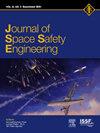Space mission safety assurance: Cybersecurity attack scenarios and risk assessment
IF 1.7
Q3 ENGINEERING, AEROSPACE
引用次数: 0
Abstract
Cybersecurity threats to critical infrastructure have advanced beyond traditional concerns such as data breaches and financial extortion, evolving into sophisticated attacks by nation-state and organized criminal entities. In particular, Space-based infrastructure faces unique vulnerabilities, where cyber intrusions can disrupt satellite operations, degrade critical services, and compromise the safety of crewed missions. The current absence of robust legal frameworks and comprehensive cybersecurity provisions within international space regulations poses significant challenges to mission resilience and incident response. Concurrently, the integration of Artificial Intelligence (AI) and Machine Learning (ML) into space systems introduces both operational advantages and novel cybersecurity risks. The lack of normative guidance or “soft law” for AI-driven space applications further amplifies these vulnerabilities, increasing the overall mission safety risk. This study proposes a goal-oriented attack tree framework to systematically identify and analyze emerging cyberattack scenarios relevant to space operations. Each scenario is evaluated using a safety risk matrix based on the likelihood of occurrence and potential operational impact. Additionally, this paper surveys existing AI/ML implementations in space systems and describes the unique threat vectors. The proposed framework aims to advance cybersecurity risk management practices and extend the preventative scope against cyber threats, particularly those affecting satellite navigation and mission-critical systems.
航天任务安全保障:网络安全攻击场景与风险评估
关键基础设施面临的网络安全威胁已经超越了数据泄露和金融勒索等传统问题,演变为民族国家和有组织犯罪实体发起的复杂攻击。特别是,天基基础设施面临着独特的脆弱性,网络入侵可能会破坏卫星运行,降低关键服务,并危及载人任务的安全。目前,国际空间法规中缺乏健全的法律框架和全面的网络安全条款,这对任务弹性和事件响应构成了重大挑战。同时,将人工智能(AI)和机器学习(ML)集成到太空系统中,既带来了操作优势,也带来了新的网络安全风险。人工智能驱动的空间应用缺乏规范性指导或“软法”,进一步放大了这些漏洞,增加了整体任务安全风险。本研究提出了一个目标导向的攻击树框架,以系统地识别和分析与空间作战相关的新兴网络攻击场景。每个场景都使用基于发生可能性和潜在操作影响的安全风险矩阵进行评估。此外,本文调查了现有的AI/ML在空间系统中的实现,并描述了独特的威胁向量。拟议的框架旨在推进网络安全风险管理实践,扩大对网络威胁的预防范围,特别是那些影响卫星导航和关键任务系统的威胁。
本文章由计算机程序翻译,如有差异,请以英文原文为准。
求助全文
约1分钟内获得全文
求助全文
来源期刊

Journal of Space Safety Engineering
Engineering-Safety, Risk, Reliability and Quality
CiteScore
2.50
自引率
0.00%
发文量
80
 求助内容:
求助内容: 应助结果提醒方式:
应助结果提醒方式:


